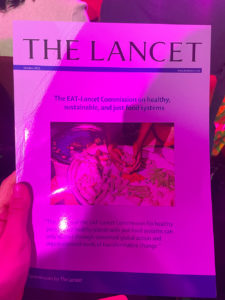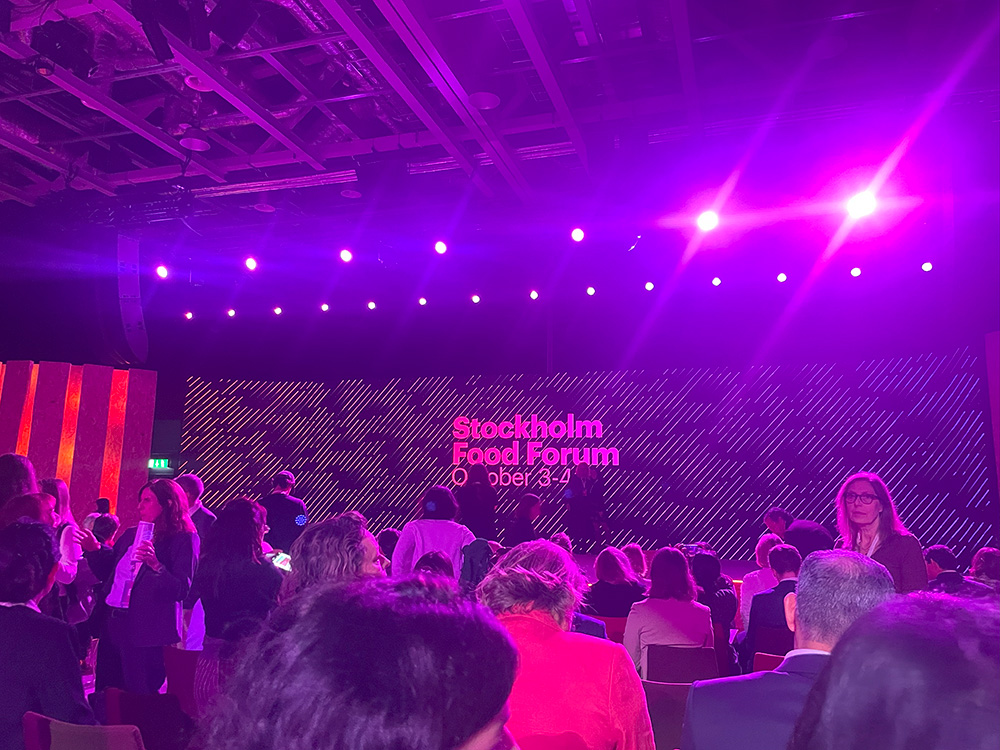Food companies – don’t put farmers last (and other learnings from the Stockholm Food Forum)
Principal Consultant Malini Bhargav reports back from the Stockholm Food Forum and the launch of the latest EAT-Lancet Commission report.
Over 700 attendees descended on the Stockholm for the launch of the 2025 EAT-Lancet Commission report – 6 years after the landmark report was first published. While the research has been expanded, it has not materially changed what constitutes a healthy, sustainable diet – also called the planetary health diet. We also haven’t seen a major transformation in people’s dietary habits since the science was first published. There are many barriers to this, and everyone has their part to play in accelerating access to sustainable, fair and healthy food systems – “access” being a key word given justice is at the heart of the new report. Today, fewer than 1% of people live in the “safe and just space” where rights and food needs are met within planetary boundaries.


I attended sessions discussing how to handle misinformation to open and honest conversations about ultra-processed foods and their potential role in a modern diet (more on these below). But first, here are 5 key learnings for how companies should talk about food and their role in the system:
- Embrace the farmer – They are on the frontline and should be treated as partners, with a seat at the table from the outset. Encourage knowledge exchange across the value chain to build shared ownership and accountability for outcomes.
- Adopt sustainable innovation – Champion new practices and showcase case studies that demonstrate measurable impact and local adaptation. Transparency in results builds trust and inspires wider adoption.
- Advance food justice – Only by bringing people on the journey and respecting their identities, values, and cultures can we enable broad adoption of healthy, sustainable diets.
- Emphasise health and taste – Create food that delights, ensuring the most delicious choice is also a healthy, sustainable and culturally relevant one.
- Communicate system-wide impact – Frame messaging within the context of the entire sustainable food system, not just individual products or offerings.
Back to the key themes – there were lots to choose from 70+ sessions and we’re sharing what feels most relevant to us and our clients:
Turning off the misinformation tap
To curb food system misinformation, we need a twofold approach: limit false sources and strengthen credible communication. This means enforcing strong online moderation, applying penalties for deliberate misinformation, and making science more accessible. As the pandemic showed, the best communication starts with a clear takeaway followed by optional detail.
Policy-making must also be protected from lobbyist influence. Industries like tobacco have long distorted facts, but countries that restrict lobbyist access have achieved better health outcomes, proving that transparency works. Finally, we should move beyond the “debate for sport” culture that prizes rhetoric over truth. Combating misinformation requires institutional responsibility, expert transparency, and a culture of respectful, evidence-based dialogue.
Making peace with nature
We produce more food than ever, yet hunger and waste persist. Protecting nature isn’t enough—we must let nature protect us. The food system will change either through conscious action or environmental crisis. Food is more than sustenance; it shapes identity, culture, and our link to the natural world. Ensuring ecological, environmental, and social prosperity through food is both a right and necessity. It is time to make peace with nature.
UPFs – friend or foe?
Food processing is not inherently bad. It can enhance safety, nutrition, and accessibility – but context matters. Some ultra-processed foods (UPFs) are shelf-stable, affordable, and nutritionally valuable, especially in regions with limited access to fresh foods. Overconsumption in high-income countries, however, contributes to poor health outcomes. The focus should be on nutritional quality, not processing level: whole grains, fortified foods, and omega-3-enriched oils can all be beneficial.
Processing can also ease the transition to plant-based diets through meat alternatives. Yet consumers face confusing marketing and unhealthy options high in salt or calories, highlighting the need for clear front-of-pack labelling. Assessing UPFs also means considering life-cycle factors such as environmental impact and food waste. Collaboration among industry, academia, and NGOs is essential to refine UPF categorisation, guide policy, and ensure processing serves nutrition, sustainability, and accessibility while empowering informed consumer choice.
Farmers on the frontline
Farmers face rising costs, climate uncertainty, and volatile markets while receiving little recognition. They persist despite challenges – almond farmers, for instance, have absorbed 50–60% cost increases while upholding environmental standards. Progress has been made in areas such as women’s rights, but exploitation and exclusion from innovation remain issues.
Building a resilient food system means strengthening the entire value chain. In California, almond growers’ focus on bee-friendly farming has led to government incentives and industry collaboration – now 86% of U.S. bee-friendly farms are almond operations. Transitioning from synthetic inputs requires practical, time-efficient alternatives, and cooperatives can help farmers gain power and financial stability. Above all, farmers must be treated as partners in food system reform.
Creating consumer desire for healthy food
Digital platforms can nudge healthier “basket-level” choices by setting goals for balanced diets and adjusting store layouts or online displays. Appeal – often overlooked –can be built through storytelling, influencers, and creative branding that make healthy foods desirable.
In emerging markets, novelty can drive engagement, while brand-led approaches can elevate unbranded foods like legumes. Training last-mile vendors as brand ambassadors ensures consistent messaging, linking home and retail environments. Investment in consumer desire remains crucial yet underfunded – despite its power to shape lasting, healthier food choices.
A parting thought for comms professionals
We can scare people with the science and the facts but unless we generate trust, people won’t believe in our solutions. We are simply creating apathy. How can we tackle this? We need to communicate better. There are challenges. In food-system terms there are emerging sustainable practices and health awareness – but progress is simply not fast enough. By telling compelling stories that highlight solutions, people are more likely to engage, share, and help accelerate positive change.
